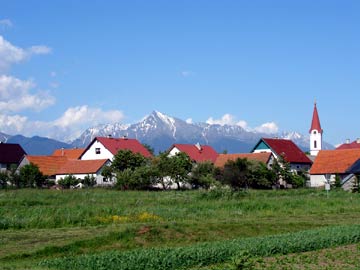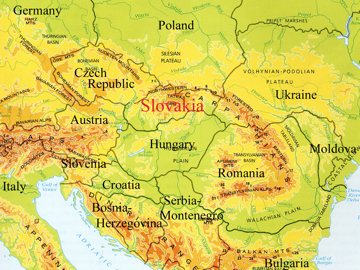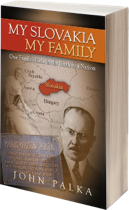Situated in the heart of Central Europe, Slovakia is a new country in political terms but an ancient one in culture and language (see History). It is a land of great beauty, encompassing the rugged Tatra Mountains, golden cultivated fields, centuries-old villages, and all the high-tech bustle of modern life.
Slovakia is bordered by Austria and the Czech Republic on the west, Poland on the north, Ukraine on the east, and Hungary on the south. Well integrated into European political and economic structures, it is a member of the European Union, NATO, the Eurozone (the group of states using the Euro as a common currency), and the Schengen Area (the area within which border controls between states have been eliminated). Despite being bound to the old Soviet Union for forty years (1948 – 1989), Slovakia has its eyes turned firmly to the West.
In size a small country, Slovakia occupies less than 20,000 square miles, slightly more than Holland or Switzerland but substantially less than the Czech Republic or Austria. Compared to American states, it is about twice the size of New Hampshire and has about three times its population, about 5.5 million. Austria, the Czech Republic, Switzerland and Holland all have substantially larger populations. Slovakia’s capital city and economic hub, Bratislava, is strategically located along the Danube River, a short distance downstream from Vienna and about a hundred miles upstream of Budapest. The second largest city, Košice, dominates Eastern Slovakia. It is home to U. S. Steel Košice, one of the largest steel plants in Central Europe and one of Slovakia’s largest employers.
Slovaks have long been known as a religious people, though the percentage of self-declared atheists is rising. In round numbers, the present population is 70% Roman Catholics, 7% Protestants (mainly Lutherans), and 13% atheists. The remaining 10% is divided between other Christian denominations.
Most Slovaks speak the Slovak language, but there is a significant Hungarian-speaking minority, especially along the southern border with Hungary. Other cultural groups in Slovakia are the Roma (Gypsies) who comprise about 2% of the population, and the Czechs, Rusyns, and Ukrainians, less than 1% each. The Slovak language is a member of the large Slavic family of languages that includes not only the closely related Czech, but also Polish, Serbo-Croatian, Ukrainian, Russian, and many others. The Hungarian language is distinctly different and basically unrelated.
For nearly a thousand years, beginning in approximately 1000 CE, the territory of today’s Slovakia was the northern counties of the Kingdom of Hungary (see History). In the 19th century, Slovaks found themselves subjected to increasing pressures to assimilate—to give up being Slovaks and to identify instead as Magyars, the ethnic Hungarians who dominated the kingdom. In response, the mid 19th century saw a surge of Slovak national awareness, the Slovak National Awakening. My great-granduncle Michal Miloslav Hodža was one of this movement’s most influential leaders. Then in 1918, Slovaks separated from Hungary and joined with Czechs to form Czechoslovakia. My grandfather Milan Hodža was a leader in this transition as well as in the development of the new country.
Czechoslovakia had a turbulent history, both because of Nazi pressure that caused its dismemberment during World War II (when Slovakia temporarily became a nominally independent but de facto Nazi-controlled state), and because of ongoing frictions between Czechs and Slovaks. Czechoslovakia was reunited after World War II but in 1948 fell under Communist control. Communism collapsed in 1989. On January 1, 1993, Czechoslovakia peacefully came to an end, and two new states, the Czech Republic and the Slovak Republic (Slovakia) were formed.



